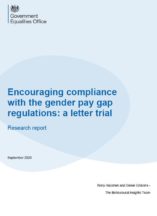New legislation came into force in April 2018 requiring all UK organisations with 250 employees or more to report their annual gender pay gap (GPG) figures to the public through a designated government website.
Ahead of this, BIT worked with the Government Equalities Office to test whether different messages were more effective at encouraging employers to comply with the new legislation. A randomised controlled trial design was used in which four different letters were sent out to 7,015 relevant employers:
- Condition 1 – control: This letter informed employers that they must report their gender pay gap figures by the set deadline
- Condition 2 – extra guidance: In addition to the information in the control letter, this letter provided employers with an extra page of guidance
- Condition 3 – social norms: In addition to the information in the control letter plus the extra guidance from Condition 2, this letter also included a social norm message highlighting that thousands of employers had already registered on the online service
- Condition 4 – honest disclosure: In addition to the information in the control letter plus the extra guidance from Condition 2, this letter included a statement that most organisations had a pay gap, and that people prefer honest disclosure of negative information
7 and 10 weeks after the letters were sent, the percentage of employers registered on the government website and reporting their GPG figures was measured. Overall, the trial found that the treatment letters did not increase reporting levels or registration levels compared to the control letter at both time points. Based on the fact that compliance reached 100% shortly after the deadline, we speculate that employers were sufficiently informed, motivated, and focused on complying with the regulations.
This piece of work was part of the Gender & Behavioural Insights Programme, funded by The Government Equalities Office. Read more of the programme’s insights for equality here.





